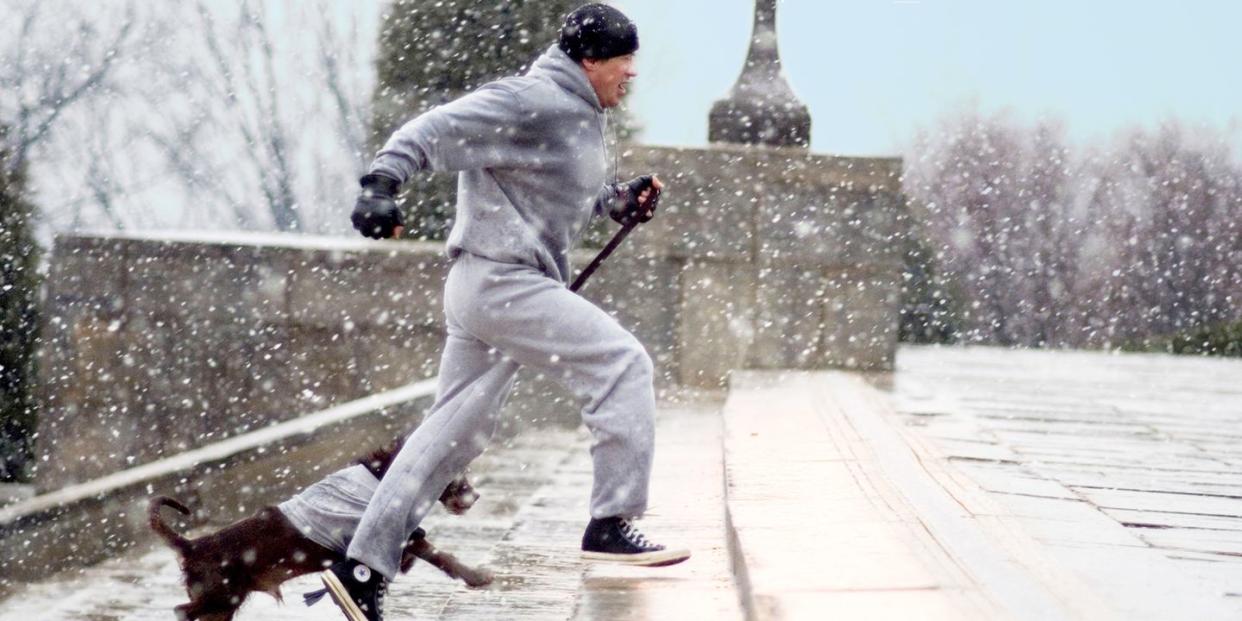Running During Winter Sucks. It Doesn't Have To.

Winter running is a challenge: You can't just leave your home when it's 25 degrees outside with wind and start jogging. Temperatures in the 30s and below tend to lock up your body and turn your extremities into icicles, causing stiff joints and tightened muscles, so cold weather running requires special preparation. That way, you can perform well, prevent injuries, and actually enjoy it.
First, a quick note: At a certain point, it's actually too cold to run. For instance, when it's zero degrees with wind chill, like it often is in Denver where I live. I recommend against that for legitimate health reasons, like hypothermia, frostbite on exposed areas, and increased chance of heart attack (if you're at risk). It's just not worth it.
But if it's not too painfully cold and you want to run on asphalt under the open sky—it sure as hell beats sitting inside doing nothing—then all it takes is some proper prep. Read on for tips so you don't freeze your ass off when it's brick outside.
1. Do a thorough warmup inside.
If you usually rush through a quick, five-minute warmup before going outside, make it 15 minutes. Spend extra time to really loosen your muscles and joints, and raise your body temperature to a light sweat. That way, when you step into the cold, it won't feel as bad, and your muscles won't get so tight.
If you have to warm up outside, wear an extra, easy-to-peel layer like a light hoodie, which you can tie around your waist later.
2. Keep your head and hands warm.
While it's been proven false that you lose the most heat through your head, it's still a damn good idea to keep your head and ears warm in the cold. Wear a thick beanie or earmuffs, which you can also easily stuff in your pockets if you get hot. Also, wear gloves. I have no idea how people can run without gloves when it's below freezing. Even with gloves, your fingers eventually get stiff and numb.
Below, you'll find some athletic styles, so you can keep your everyday wool gloves and cashmere beanie nice:
3. Wear a base layer.
A base layer is ideal for any cold weather run because it keeps you as warm as a thick coat would while being significantly less cumbersome, and besides, it wicks away moisture. Wear a base layer top and bottom, and from there add extra layers based on temperature. These are some solid options:
4. Wear shoes with traction.
Ideally, run on a path that's clear of snow and ice. If you're running on snow, however, wear shoes with great traction and protection, and pair them with warm, comfortable socks that keep your feet dry. Also, stay focused—the path will likely have slippery areas. Footwear brands put out sneakers specifically designed for winter running, like these:
5. Underdress by a few degrees.
You should dress for warmth, but you shouldn't dress like you're climbing Mount Everest. As you run, your body temperature increases—wear too much, and it'll get mad hot.
Instead, underdress slightly: If it's 25 outside, dress like it's 45. (Adjusting by 20 degrees is a good rule of thumb.) Once you start running, you'll heat up to compensate. Unless it's cold and windy. In that case, bundle up appropriately, or say "screw it" and stay inside with a cup of tea.
6. Stay aerobic.
Your heart beats faster when it's cold, which intensifies any outdoor run. So, unless you're training for a specific event, cold weather isn't really the best time to channel your inner Usain Bolt.
Prevent extra stress on your body by staying in your aerobic zone (calculate your target heart rate here; it changes depending on your age). It will feel slower than what you're used to, but you will still get the same benefits. Use it to improve your conditioning, maintain your running muscles, and simply enjoy the outdoors with a running partner or in solitude.
7. Stay hydrated.
You might not sweat much when it's 10 degrees out, but hydration is still important. Drink liquids before, during, and after a run.
8. Time yourself.
Keep your run between 30 and 60 minutes. Highly experienced runners can do slightly more, but after 90 minutes, you risk compromising your immune system. (Not to mention, spending that much time in the cold just sucks.)
9. Finish fast.
Your body temperature will drop quickly after you finish your run, so prepare in advance. Minimize the distance from the end of your run to a warm place. If you can finish your run at your front door, perfect; if you have to drive back home, have a thick jacket and hot beverage waiting for you in the car.
10. Keep at it.
Since you're interested in cold weather running—snow, sleet, and freezing temps be damned—then you're definitely dedicated. So even if your first cold weather run is surprisingly a slog, the next one will be better. And should it get too hairy out there even for you, you can always run inside. Gyms are compromised this year, but a treadmill (like this affordable, foldable model for small apartments) will do the job 'til spring.
You Might Also Like

